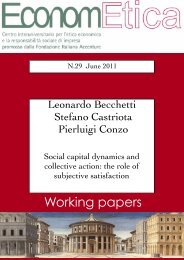WP15 November 2009 - Econometica
WP15 November 2009 - Econometica
WP15 November 2009 - Econometica
Create successful ePaper yourself
Turn your PDF publications into a flip-book with our unique Google optimized e-Paper software.
6. Conclusions<br />
The present paper approached the theory of team reasoning from an empirical point of view in<br />
order to verify:<br />
1. the role of the common reason to believe in the theory of team reasoning;<br />
2. the effect of the reduction of social distance on the likelihood that we-frame comes to mind<br />
of players involved in a game characterized by the property of strong interdependence.<br />
With respect to the first point, we were interested in analyzing if the belief in the other player’s<br />
behavior is significantly correlated with the adoption of team reasoning. With respect to the second<br />
point, we reduced the social distance between subjects by introducing in a standard Travelers’<br />
Dilemma a voluntary and a compulsory meeting between the two paired players and we studied the<br />
effect of these two treatments on the probability that team reasoning was endorsed.<br />
Two main findings characterize our empirical analysis. First, the notion of “common reason to<br />
believe” used by Sugden (2003) to tackle the so called “internal problem of team reasoning” seems<br />
appropriately capture the internal logic of team reasoning. When the belief is lower than the<br />
maximum, we find that players who endorse the I-mode are much more than players who follow the<br />
team reasoning. It seems that, outside the “implicit agreement” around the { C i , C j } choice,<br />
individually rational behavior largely dominates team rational one. The role of belief is confirmed<br />
by the fact that the majority of players who think that their counterpart is going to play the<br />
maximum, endorse the team reasoning. Second, when the meeting is a compulsory characteristic of<br />
the game, there is a significant increase of players who endorse team reasoning by choosing the<br />
maximum under the belief that also the counterpart is doing the same. This result may be<br />
interpreted as a positive and significant effect of the reduction of social distance on the probability<br />
that the we-frame comes to mind. Players who know that after the game the members of the team<br />
will meet are more likely to adopt team reasoning.<br />
Even though different authors used the idea of team reasoning “in different ways, and applied it<br />
to different but overlapping sets of phenomena” (Sugden 2003, p.166) there is a surprisingly lack of<br />
19



